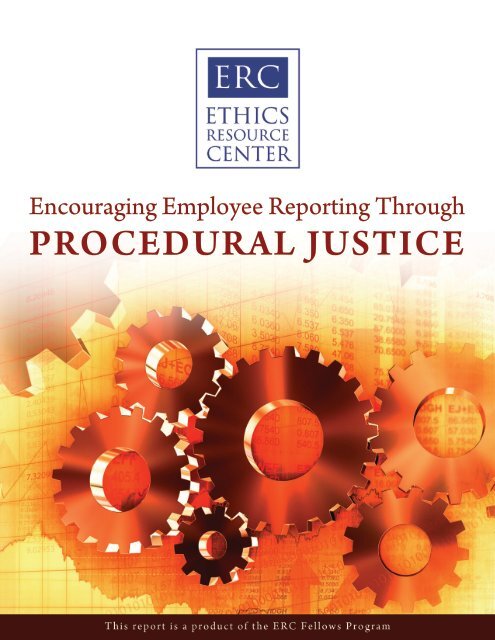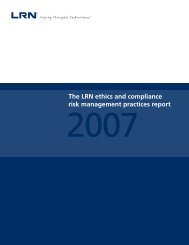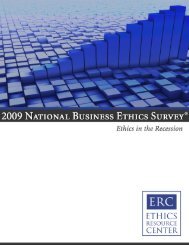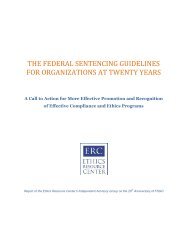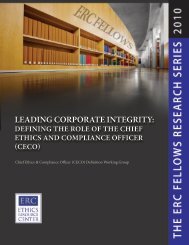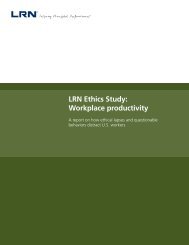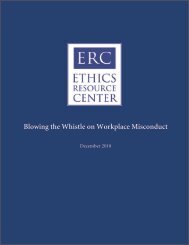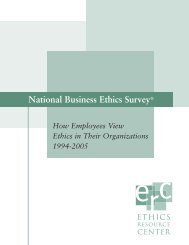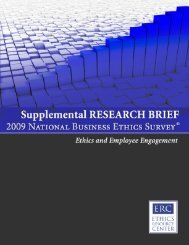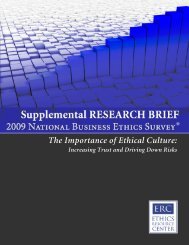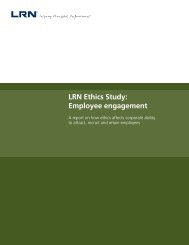PROCEDURAL JUSTICE - Ethics Resource Center
PROCEDURAL JUSTICE - Ethics Resource Center
PROCEDURAL JUSTICE - Ethics Resource Center
Create successful ePaper yourself
Turn your PDF publications into a flip-book with our unique Google optimized e-Paper software.
Encouraging Employee Reporting Through<br />
<strong>PROCEDURAL</strong> <strong>JUSTICE</strong><br />
Encouraging Employee Reporting Through<br />
<strong>PROCEDURAL</strong> <strong>JUSTICE</strong><br />
1
The <strong>Ethics</strong> <strong>Resource</strong> <strong>Center</strong> (ERC) is America’s oldest nonprofit organization<br />
devoted to the advancement of high ethical standards and practices in public<br />
and private institutions. Since 1922, ERC has been a resource for public and<br />
private institutions committed to a strong ethical culture. ERC’s expertise also<br />
informs the public dialogue on ethics and ethical behavior. ERC researchers<br />
analyze current and emerging issues and produce new ideas and benchmarks<br />
that matter — for the public trust.
Encouraging Employee Reporting Through<br />
<strong>PROCEDURAL</strong> <strong>JUSTICE</strong><br />
TABLE OF CONTENTS<br />
Overview...............................................................................................................................5<br />
Grievance Resolution and Why it Matters..................................................................................................7<br />
Study Methodology.....................................................................................................................................10<br />
The Reporting Experience.........................................................................................................................12<br />
Does Procedural Justice Make a Difference in Acceptance......................................................................15<br />
The Impact of Procedural Justice Differs With the Issue.....................................................................17<br />
Procedural Justice Enhances Belief in the Company...............................................................................19<br />
Summary of Key Findings..........................................................................................................................20<br />
Implications of Our Findings .......................................................................................22<br />
References..........................................................................................................................24<br />
Appendix..........................................................................................................................26<br />
3
Encouraging Employee Reporting Through Procedural Justice<br />
The ERC Fellows would like to thank the following<br />
Academic Fellows for their contributions to this study:<br />
Tom R. Tyler<br />
Law School/Psychology Department<br />
Yale University<br />
Celia Gonzalez<br />
Kennedy School of Government<br />
Harvard University<br />
Debra L. Shapiro<br />
Robert H. Smith School of Business<br />
University of Maryland<br />
Linda K. Trevino<br />
Smeal College of Business<br />
Pennsylvania State University<br />
and<br />
John Dienhart<br />
Albers School of Business and Economics<br />
Seattle University
Encouraging Employee Reporting Through<br />
<strong>PROCEDURAL</strong> <strong>JUSTICE</strong><br />
OVERVIEW<br />
Addressing employee concerns and workplace policies and practices is among business management’s most significant<br />
responsibilities. Given the dual objectives of proper adjudication and achieving a degree of satisfaction for all parties<br />
involved, the relative success or failure of the resolution process can have a major impact on employee morale and the<br />
company’s operating effectiveness.<br />
When considering these objectives, a number of questions arise. First, can companies design mechanisms that encourage<br />
employees to share their concerns in order to help the company identify and correct problems before they become<br />
widespread Once concerns are identified, can the company resolve complaints in a way that aggrieved employees will<br />
accept – even when the outcome is disappointing or when legal constraints may limit what the company can say about<br />
any actions taken Do particular procedural techniques affect the way employees judge the final results Are the same<br />
techniques universally effective for all types of concerns, or must companies tailor the process to fit specific categories of<br />
grievances<br />
A company that finds the right answers to these questions can improve its prospects in a number of ways. Employees<br />
who trust the complaint resolution process are more likely to share concerns so that management has an early warning of<br />
possible systemic issues. Satisfied employees are less likely to take their complaints to outsiders such as the news media<br />
or government, sparing the company from the bad publicity, distraction, or legal action that might result from external<br />
involvement. By instilling confidence that they will be treated fairly, effective grievance resolution can enhance employee<br />
loyalty and commitment to the company.<br />
Conversely, an ineffective system for resolving disputes and grievances can undermine morale and erode loyalty. Because<br />
companies have a legal obligation to promote good ethics in the workplace, a deficient process can weaken a company’s<br />
defense in the event of outside challenges or legal charges regarding its ethical standards.<br />
In an attempt to address these questions, this paper examines employee attitudes at companies that operate dedicated<br />
5
Encouraging Employee Reporting Through<br />
<strong>PROCEDURAL</strong> <strong>JUSTICE</strong><br />
hotlines for employee reporting of workplace complaints, grievances, and possible misconduct. We surveyed employees<br />
who had used the hotline to report concerns, overlaid the responses with the outcome of their complaints, and also<br />
discussed the process with the company officials who reviewed the reports.<br />
In particular, we focused on the concept of “procedural justice” and whether its consistent application in response to<br />
complaints might help win employee acceptance – even when the reporters are unhappy with the substantive outcome.<br />
What we found is good news for companies. It turns out that the way companies address complaints is often as important<br />
to employees as the outcome.<br />
We found that a procedurally just process – defined as fair decision-making process and respectful treatment of employees<br />
and their concerns – substantially increases the chances that reporting employees will accept the outcome. To be sure,<br />
the impact of procedural justice varies with the nature of the dispute and its impact is not as strong in cases involving<br />
discrimination, harassment or violence. But, as a general rule, companies that work hard to provide procedural justice<br />
will greatly improve the odds that employees will accept the results of the handling of their ethics reports.<br />
We found that a procedurally just process – defined as<br />
fair decision-making process and respectful treatment of<br />
employees and their concerns – substantially increases the<br />
chances that reporting employees will accept the outcome.<br />
6
Encouraging Employee Reporting Through<br />
<strong>PROCEDURAL</strong> <strong>JUSTICE</strong><br />
GRIEVANCE RESOLUTION AND WHY IT MATTERS<br />
Businesses have numerous reasons for providing employees with a way to report problems in their workplace, and also for<br />
finding effective ways to address these concerns. First, such reports often reveal workplace deficiencies that, if remedied,<br />
can make the organization more efficient and effective. When employees report substantive problems through internal<br />
company mechanisms, management has an opportunity to nip them in the bud before they infect the system. If problems<br />
have been festering for some time, employee complaints offer a chance to limit the damage and prevent them from<br />
spreading further.<br />
Learning about such issues in a timely fashion also may enable companies to avoid the negative publicity and cleanup costs<br />
that might result if unhappy employees take their concerns to the news media, government regulators, or post them on<br />
an online forum. Thus, companies have multiple incentives for providing an effective way for employees to report and<br />
resolve concerns internally.<br />
Further, unhappy employees are not good workers. Irrespective of the merits of a report, an employee who files a<br />
complaint believes there is a real issue. Addressing this perception is a distinct issue separate and apart from whether<br />
there is a real underlying organizational issue that needs attention. Even if the complaint does not stand up under<br />
investigation, the company may still benefit from an effective response to the employee who made the report.<br />
In addition to these operational reasons for responding to employee concerns, businesses are legally mandated to make<br />
efforts to identify and correct ethical problems. Establishing a viable mechanism for employee reporting combined with<br />
genuine efforts to address complaints and fix problems arguably demonstrates commitment to an ethical workplace and<br />
helps make the case that the company is working to meet its legal obligations.<br />
With these benefits in mind, many companies have created “hotlines” or helplines for employee reporting. While these<br />
7
Encouraging Employee Reporting Through<br />
<strong>PROCEDURAL</strong> <strong>JUSTICE</strong><br />
mechanisms are just one of several channels through which employees make reports, 1 they tend to be the primary means<br />
for companies to gather statistics about employee reporting. But helplines are effective only if employees actually use<br />
them, and that is not a given. One way to motivate employees to take advantage of hotlines is a commitment to procedural<br />
justice that ensures reports are handled fairly and reporters are treated with respect.<br />
Research suggests that people react favorably to fair procedures, suggesting that if employees believe that their complaints<br />
will be handled fairly, they are more likely to report and to be satisfied with the reporting process (see Colquitt, 2008;<br />
Colquitt, Greenberg & Zapata-Phelan, 2005; Huo, 2002; Jones & Skarlicki, 2003; Leventhal, 1980; Lind & Tyler, 1988; Tyler,<br />
2000; Tyler & Blader, 2000, 2003, 2009).<br />
But implementation of procedural justice-based management strategies is more challenging than might be expected<br />
because companies are often constrained by laws and policies that limit what they can say about their findings and what<br />
they’ve done about them.<br />
Companies therefore face a conundrum: procedures that employees see as fair (i.e. transparency) are essential for building<br />
trust, but investigators cannot always be fully transparent. Sometimes investigators can share information about what<br />
evidence was gathered and what actions were taken, but often they cannot. Thus, procedural justice approaches are<br />
inherently handicapped because investigators often are blocked from creating conditions that promote trust.<br />
Further, many reports of ethical concerns cannot be validated, whatever their merit, and even when they are substantiated,<br />
the actions taken are often confidential. The reporter is frequently unaware of what, if anything, happened in response to<br />
the report. Even when they know the complaint was pursued, they do not know the outcome beyond the vague assurance<br />
that “appropriate action was taken.”<br />
1. For example, in the <strong>Ethics</strong> <strong>Resource</strong> <strong>Center</strong>’s research, employees indicate several places where they tend to report misconduct, including<br />
supervisors, higher management, ombudsmen, and the ethics officer. See <strong>Ethics</strong> <strong>Resource</strong> <strong>Center</strong> (2012) Inside the Mind of<br />
a Whistleblower. Arlington, VA: <strong>Ethics</strong> <strong>Resource</strong> <strong>Center</strong>.<br />
8
Encouraging Employee Reporting Through<br />
<strong>PROCEDURAL</strong> <strong>JUSTICE</strong><br />
This conflict illustrates the paradox of ethics hotlines. They can enable companies to learn about problems and fix them,<br />
but confidentiality requirements may prevent employees from feeling satisfaction with the results and may discourage<br />
future reporting. Given that changing disclosure rules is generally unlikely, companies’ best hope is that procedural justice<br />
or fairness can generate enough employee satisfaction to sustain hotlines’ effectiveness. This study attempts to test that<br />
proposition by examining employees’ actual experience and attitudes about reporting at companies where hotlines are the<br />
designated method for employee complaints.<br />
This study looks at the effectiveness of hotlines by examining reporter’s post-experience evaluations of their reporting<br />
experience. The procedural justice of that experience is linked to reporter satisfaction and willingness to accept the results<br />
of the investigation, as well as to the continued commitment of the employee to the organization. The impact of two<br />
aspects of the reporting experience is considered: first, whether reporters know the outcome of their report and whether<br />
procedural justice promotes acceptance when outcomes are not known; and second, whether or not the report was<br />
substantiated. The key issue is whether procedural justice can promote acceptance even when reporters are disappointed<br />
by, or unaware of, the outcome.<br />
Employees who trust the complaint resolution<br />
process are more likely to share concerns<br />
so that management has an early warning of<br />
possible systemic issues.<br />
9
Encouraging Employee Reporting Through<br />
<strong>PROCEDURAL</strong> <strong>JUSTICE</strong><br />
STUDY METHODOLOGY<br />
The study is based on hotline experience at five companies which agreed to ask reporters whether they would participate<br />
in a survey about their use of the hotline and the report management process. Admittedly, hotlines are only one means<br />
by which employees report misconduct. Nevertheless, we focused in this study on hotlines because they provided the<br />
companies involved the most effective means to access a representative pool of participants in a relatively controlled<br />
environment. According to ERC’s previous research, only a small percentage of employee reports of misconduct are<br />
received through hotlines; 2 still, it is a reasonable expectation that the findings of this study are applicable to reports that<br />
come in through other channels.<br />
The study is based upon reports from 612 respondents who completed a web based questionnaire. During the study<br />
period everyone who called to report an ethics concern was asked, after the usual report taking procedures were followed,<br />
if they were interested in participating in a survey about their experience with the report management process. Those<br />
who responded affirmatively provided an email address and were contacted by the researchers after their case had been<br />
resolved. Upon contact, potential respondents were asked to complete the short, confidential, on-line survey. Those who<br />
did not complete the survey after the initial invitation were sent an email reminder several weeks later to encourage their<br />
participation in the study.<br />
Most of those who initially indicated an interest in participating in the study did not do so. The responses represent<br />
13 percent of those who called and indicated an initial interest in the study. However, they do reflect a diverse set of<br />
employees. Respondents were 50 percent white; 26 percent female; 38 percent age 25 or younger; 79 percent age forty or<br />
younger; 44 percent college graduates or higher; and 53 percent with an income of less than $20,000. We note that the low<br />
response rate suggests our data may not reflect the full range of reporting.<br />
2 In fact, in its 2011 National Business <strong>Ethics</strong> Survey report Inside the Mind of the Whistleblower, ERC researchers found that 5% of<br />
employees utilized the hotline to make a first report of observed misconduct. The percentage rose to 9% of employees when they<br />
made a second report of the same observed wrongdoing. See <strong>Ethics</strong> <strong>Resource</strong> <strong>Center</strong> (2012) Inside the Mind of a Whistleblower.<br />
Arlington, VA: <strong>Ethics</strong> <strong>Resource</strong> <strong>Center</strong>.<br />
10
Encouraging Employee Reporting Through<br />
<strong>PROCEDURAL</strong> <strong>JUSTICE</strong><br />
In particular, an examination of the results suggests that people were particularly likely to complete the evaluation when<br />
they were dissatisfied with some aspect of their experience. Thus, it is possible that the impact of procedural justice is<br />
smaller in the study population than in the full universe of employees who file complaints through hotlines because the<br />
study did not capture the full range of reactions. Satisfied reporters may be less likely to be motivated to complete the<br />
survey. Put another way, it is possible that procedural justice has a greater impact than suggested by the study, raising<br />
questions for further inquiry.<br />
In many cases, the survey responses were supplemented by the company with objective data regarding several parameters<br />
of each report. These parameters included the content area of the report, the priority level of the report, the ultimate<br />
substantiation of the report, and the amount of time it took for the report to be closed.<br />
When both the objective and the subjective information were collected for a report, these two sets of data – the first<br />
drawn from the responses of reporters, and the second drawn from objective information concerning an investigation of<br />
the report – were combined to form a comprehensive representation of the reporting experience. The analysis presented<br />
below is based on this combined data set.<br />
11
Encouraging Employee Reporting Through<br />
<strong>PROCEDURAL</strong> <strong>JUSTICE</strong><br />
THE REPORTING EXPERIENCE<br />
What shaped the willingness (or unwillingness) of reporters to accept the outcome of the investigation Before trying to<br />
answer that question, we must first consider the factual data, specifically whether or not the investigator felt that there<br />
was enough evidence of a problem to potentially require company action and how the complaining reporters felt about the<br />
review process.<br />
Here are the bare facts:<br />
JJ<br />
JJ<br />
JJ<br />
JJ<br />
JJ<br />
38 percent of the reports were “unsubstantiated.” They did not stand up under initial scrutiny by [ethics<br />
officials] and were effectively dismissed without further action;<br />
21 percent were fully substantiated;<br />
12 percent were partly substantiated at the initial stage;<br />
29 percent were referred by ethics officials to the human relations or legal department for additional inquiry. In<br />
three quarters of these cases (75 percent) the objective outcome was unfavorable to the complainant; 3<br />
Still, reporters were generally positive about the process;<br />
JJ<br />
42 percent said the investigative procedures were fair 4 ;<br />
3. To determine outcome favorability reporters were asked whether the outcome gave them what they wanted and how the outcome<br />
compared to their expectations.<br />
4. Questions were asked about the reporter’s perception of the fairness of the procedures used in the process of how to handle the<br />
specific issues raised in the report, how the reporters viewed the fairness of their personal treatment, and their overall view of the<br />
fairness of the report handling procedure.<br />
12
Encouraging Employee Reporting Through<br />
<strong>PROCEDURAL</strong> <strong>JUSTICE</strong><br />
JJ<br />
40 percent said that decisions were made fairly 5 ;<br />
JJ<br />
50 percent indicated that they had been treated fairly 6 .<br />
The favorability ratings, which are seemingly high considering the preponderance of negative outcomes, support the<br />
theory that fair treatment can help mitigate the influence of unfavorable or unknown investigations. The procedural<br />
justice approach rests on the idea that people accept reports because of the process of the investigation, not its outcome. In<br />
the cases studied, the reporters rated the procedures as fair much more often than they approved of the outcome. These<br />
responses indicate that reporters are sufficiently open-minded to recognize a fair process even when they dislike the<br />
outcome. They also suggest that focusing on fair procedures may satisfy large numbers of employees no matter what the<br />
outcome.<br />
As an initial test of the notion that fair procedures can shape acceptance, reporters were asked to indicate how willing they<br />
were to accept the outcome. 7 The survey numbers were mixed.<br />
About two thirds (68% percent) of those who reported expressed a general unwillingness to accept the outcome. However,<br />
of this group only 39 percent of respondents indicated that they would continue to press the issue further internally and<br />
5. Questions were asked about whether the decisions made were factually based, whether the investigator was neutral and unbiased,<br />
whether the rules were applied consistently, whether consideration was given to the issues raised by all parties, whether appropriate<br />
evidence was gathered in the decision making process, and whether the reporter’s concerns were addressed by the investigation.<br />
6. Questions were asked about whether the reporter felt their rights were respected, whether they were treated with respect and dignity,<br />
whether the procedures were clearly explained, whether the investigator cared about their needs and concerns, whether the<br />
investigator wanted to do what was best for the reporter, and whether the investigator considered what was said in the initial report<br />
before acting.<br />
7. Questions were asked about whether the reporter was pleased with how the report was handled, how willing they were to accept<br />
the current resolution of the issue(s), if a similar issue came up in the future, how likely would they be to report it, if another issue<br />
came up in the future, how willing would they be to have it handled with a similar process, how likely is it that they would try to<br />
find ways to appeal the decision or otherwise further pursue the issue within the company, and how likely it was that they would<br />
try to find ways to go outside of the company to pursue this dispute.<br />
13
Encouraging Employee Reporting Through<br />
<strong>PROCEDURAL</strong> <strong>JUSTICE</strong><br />
only 31 percent said that they would consider going outside the organization. 8 There were, therefore, a number of people<br />
who were reluctant to accept the outcome, but who decided to stop acting on their concerns despite their reservations.<br />
In considering the nature of the reporting process, it is important to remember that only those with a grievance or problem<br />
turn to the hotline. People do not call to express appreciation. As with any agency that manages problems (e.g. the courts,<br />
the police) it is impossible to resolve every problem in a way that will be satisfactory to the reporter and, in our survey,<br />
there was often dissatisfaction with both the outcome and the procedure. However, the majority of reporters indicated that<br />
they would neither try to appeal internally nor consider going outside the organization. So the handling of hotline reports<br />
was successful enough that most employees kept their concerns within the company. Of course, it is also possible that<br />
employees simply gave up. We will address this later in the report when we look at the impact of the reporting experience<br />
on people’s relationship to their company.<br />
8. Of course these actions are not mutually exclusive and a reporter could pursue both courses of action.<br />
14
Encouraging Employee Reporting Through<br />
<strong>PROCEDURAL</strong> <strong>JUSTICE</strong><br />
DOES <strong>PROCEDURAL</strong> <strong>JUSTICE</strong> MAKE A DIFFERENCE<br />
IN ACCEPTANCE<br />
To determine the impact of the procedures, we used regression analysis to compare the relative influence of outcome<br />
favorability and perceived procedural justice on the way reporters evaluated the process (see Table 1). Surprisingly,<br />
whether or not their complaint was substantiated by the investigators had little impact on reporter perceptions of the<br />
process. On the other hand, and not surprisingly, complainants were much more likely to accept outcomes they thought<br />
were favorable. 9<br />
Significantly, the primary factor influencing the degree of acceptance was whether or not reporters felt the procedure used<br />
to handle their report was fair. Broken down further, reporters indicated that the quality of decision-making was slightly<br />
more important to acceptance than the quality of the personal treatment they received, but that positive perceptions of<br />
both of those elements contributed to acceptance. The regression equation shown in Table 1 indicates that procedural<br />
justice was central to acceptance (beta = 0.49); while perceived outcome favorability played a secondary role (beta = 0.35).<br />
The crucial management issue is whether those dealing with reports can rely on fair procedures to help resolve conflicts<br />
and address the issues that underlie employee reports. Our analysis suggests that the answer is “yes.” Over and above<br />
reporters’ reactions to the outcomes of the process, experiencing fair report management makes it more likely they will<br />
willingly accept investigators’ decisions.<br />
That’s particularly impressive when one considers that most people who report a problem or grievance begin the process<br />
with some dissatisfaction about events in the workplace and might be predisposed to be unhappy about outcomes,<br />
especially when they do not like the final resolution.<br />
9. The correlation between the objective and perceived outcome was r=0.19.<br />
15
Encouraging Employee Reporting Through<br />
<strong>PROCEDURAL</strong> <strong>JUSTICE</strong><br />
Further, the investigators at the companies studied were not specifically trained in procedural justice. This suggests that<br />
employee perceptions will improve even more, provided investigators are given the tools to ensure and effectively present<br />
fairness.<br />
The crucial management issue is whether those dealing<br />
with reports can rely on fair procedures to help resolve<br />
conflicts and address the issues that underlie employee<br />
reports. Our analysis suggests that the answer is “YES.”<br />
Experiencing fair report management makes it more likely<br />
they will willingly accept investigators’ decisions.<br />
16
Encouraging Employee Reporting Through<br />
<strong>PROCEDURAL</strong> <strong>JUSTICE</strong><br />
THE IMPACT OF <strong>PROCEDURAL</strong> <strong>JUSTICE</strong> DIFFERS<br />
WITH THE ISSUE<br />
While procedural justice is always important, it is not always decisive. In some types of cases, especially were a personal<br />
threat is significant and/or ongoing, outcomes are more important than procedural fairness in influencing employee<br />
acceptance.<br />
Our analysis was possible because investigators coded their reports to reflect the type of issue covered by the report, as<br />
shown in Table 2. All told, we reviewed 612 reports in four categories. The first category (261 reports) involves job<br />
related decisions with a personal impact – transfers, promotions, termination, performance reviews and job conditions.<br />
The second (89 reports) involves work policy issues – hours and wage policy; leave policy; payroll and employment law<br />
concerns. Another 166 reports were about interpersonal conflicts with one’s supervisor or coworkers. The fourth, and<br />
most alarming, category with 96 reports concerned violence, harassment, and discrimination.<br />
Table 2 shows that procedural justice is always relevant and generally important, but that in cases of violence, harassment<br />
and discrimination people put more weight on the outcome (beta = .47) than the procedure (beta = .43) Otherwise,<br />
procedural justice effects are strong and resilient across issues. For example, on “work policy issues,” the influence of<br />
procedural justice (beta = .57) overwhelmed outcome (beta = .16). These breakdowns tell us that procedural justice is<br />
a generally good framework for managing hotline reports, and even in cases of violence and discrimination, procedural<br />
justice matters. However, they also suggest that in more extreme cases, the outcome is relatively more important.<br />
We also considered how employees react when their report is not substantiated (Table 3) or when the outcome is not<br />
known (table 4). Our analysis shows that in both cases, a belief that the review process was fair is a critical influence<br />
in shaping acceptance and outweighs outcome favorability. That’s significant because it strongly suggests that fair<br />
procedures are a valuable tool when addressing transparency limits and other constraints on the review process. The<br />
positive impact of procedural justice is therefore a welcome partial remedy for the conflict between confidentiality rules<br />
and transparency of the hotline investigatory process.<br />
17
Encouraging Employee Reporting Through<br />
<strong>PROCEDURAL</strong> <strong>JUSTICE</strong><br />
Procedural justice also appears to exert a positive influence in difficult cases where there is insufficient evidence to<br />
substantiate a claim that may, in fact, have merit. Despite the deep disappointment that may be felt by a complainant in<br />
this circumstance, our findings suggest that fair procedures boost the odds of acceptance.<br />
The positive impact of procedural justice is therefore<br />
a welcome partial remedy for the conflict between<br />
confidentiality rules and transparency of the hotline<br />
investigatory process.<br />
18
Encouraging Employee Reporting Through<br />
<strong>PROCEDURAL</strong> <strong>JUSTICE</strong><br />
<strong>PROCEDURAL</strong> <strong>JUSTICE</strong> ENHANCES BELIEF IN THE<br />
COMPANY<br />
Ideally it would be possible to manage hotline reports in ways that minimize damage to the organization and perhaps even<br />
build organizational commitment. To test the role of procedural justice in shaping reporter’s broader relationship to the<br />
company, participants in the study were asked about their post-reporting view of their company’s commitment to ethics 10 ;<br />
their degree of organizational commitment 11 ; and their level of voluntary job related helping behavior (extra-role behavior) 12 .<br />
Our analysis suggests that procedural justice helps to build a positive organizational climate. Those who believe that their<br />
report was handled fairly have a more positive view of their companies’ commitment to ethics, and they are more likely to<br />
think that reporting problems is a good idea. They also have a more positive level of commitment to the company. The<br />
impact on voluntary help in the workplace is not as strong. That finding may reflect the fact that such volunteerism is<br />
generally confined to a small subset of workers to begin with. However, it reinforces the suggestion that experiencing fair<br />
treatment in response to making a report builds a positive identification with one’s company.<br />
As would be expected, one experience with reporting does not fully explain an employee’s orientation toward the company,<br />
which is shaped by numerous factors over a long period of time. But that orientation is clearly influenced, for good and ill,<br />
by the employees’ perceptions about the degree of procedural justice they experienced.<br />
10. We asked reporters whether they have given up trying to make suggestions for improvements, whether they think efforts to make<br />
improvements in this company usually fail, whether they feel attempting to change what they think is wrong in the company is<br />
more trouble than it is worth, if they tried to stop misconduct in the company things would get worse, and whether reports of misconduct<br />
are given careful consideration in the company.<br />
11. We asked reporters if they are happy working at their company, if they really enjoy the work they do, if they view their job as “great”<br />
as compared to most jobs, if they intend to stay at their present job, if they feel their company is one of the best in the field, if they<br />
can think of another company they would rather work for, if they are proud to tell others where I work, if when someone compliments<br />
their company it feels like a personal compliment, if working at their company is really important to the way they think of<br />
themselves as people and how often they think about quitting.<br />
12. We asked reporters how often they volunteer to do things that are not required in order to help, volunteer to orient new employees,<br />
help others with work related problems, put in an extra effort to do their job well, and share their knowledge with others.<br />
19
Encouraging Employee Reporting Through<br />
<strong>PROCEDURAL</strong> <strong>JUSTICE</strong><br />
SUMMARY OF KEY FINDINGS<br />
This report supports five conclusions:<br />
1. Whether people accept the resolution of an ethics investigation and disposition does not wholly depend on<br />
whether their report is substantiated and/or whether they received the outcome they wanted. Acceptance also<br />
is linked to whether they believe that a fair procedure was used to handle their report. In fact, such procedural<br />
justice judgments have an influence that is distinct from, and usually stronger than, the impact of both the<br />
objective outcome and the reporters’ perceptions of the outcome.<br />
2. In considering whether the process was fair, reporters focused on two issues: the quality of the company’s<br />
decision making (neutral, factual, unbiased, consistent) and trust in the investigatory team (whether they<br />
considered the reporter’s concerns and sincerely tried to do the right thing). Courtesy and respect also were<br />
important to reporters.<br />
3. The procedural justice effect is robust. It is found across different types of reports. And, it occurs even when<br />
reporters receive negative outcomes or have no information about what type of outcomes have occurred. In<br />
other words, it works within the context of rules that restrict the actions of investigators in work settings.<br />
4. Procedural justice has a positive impact on broader feelings about the company. As one might anticipate,<br />
the quality of the reporting and investigatory experience affects the way employees feel about the company.<br />
When the process is marked by fairness, reporters are more likely to credit the company with caring about<br />
ethical issues and taking complaints seriously. A positive experience also makes it more likely employees<br />
will report future problems or concerns. This finding should allay managers’ concerns that the investigatory<br />
process itself can negatively affect attitudes and behavior because reporters feel alienated from their company<br />
and workgroup. Fair handling of their report can increase loyalty and commitment to the company, and is<br />
generally more important than the substantive outcome.<br />
20
Encouraging Employee Reporting Through<br />
<strong>PROCEDURAL</strong> <strong>JUSTICE</strong><br />
5. The procedural justice benefit was less significant with reports of violence, harassment and discrimination. In<br />
those instances, which relate to the employee’s sense of personal comfort and security on a day-to-day basis, the<br />
final outcome, not fairness, is the more important factor in acceptance. While fairness remains important, this<br />
finding is a noteworthy exception to the general findings. It also tells us that extra care is appropriate for these<br />
issues and suggests that companies may want to prioritize distinct procedural elements for each type of issue<br />
category.<br />
A Procedurally Just Process:<br />
• Clearly explains the company’s procedures for<br />
investigation and resolution of reports;<br />
• Consistently follows those stated procedures;<br />
• Treats reporters with dignity, respect, and concern for<br />
their well-being;<br />
• Takes into account the issues raised by all parties;<br />
• Conducts investigations in a neutral and unbiased<br />
manner;<br />
• Explains the resolution of the case based on the facts.<br />
21
Encouraging Employee Reporting Through<br />
<strong>PROCEDURAL</strong> <strong>JUSTICE</strong><br />
IMPLICATIONS OF OUR FINDINGS<br />
Our findings represent good news for companies and employees alike. On the one hand, emphasis on procedural justice<br />
should encourage employee reporting, which helps companies identify and repair problems in a timely fashion. Secondly,<br />
to the extent companies rely on a procedural justice strategy – and our analysis suggests it’s in their self-interest to do<br />
so – employees can expect a fair shake when they pursue grievances and other workplace concerns through internal<br />
mechanisms such as hotlines.<br />
For companies, a viable system for identifying and resolving ethics issues has both internal and external benefits.<br />
Internally, the company can address organizational problems before they become an undermining factor. Externally,<br />
companies want to have a viable program as a legal defense in the event of any litigation involving their ethical<br />
commitments. Under Federal Sentencing Guidelines, the severity of penalties will be shaped at least in part by the<br />
company’s efforts to create an organizational structure capable of detecting and repairing problems. Developing selfmonitoring<br />
mechanisms is a defense for when ethics problems arise.<br />
The first problem for companies has been developing an effective way to encourage ethics reporting. Our findings suggest<br />
that procedural justice approaches provide such a mechanism because they generally increase the chances that employees<br />
will accept the outcome and believe it is worthwhile to report problems in the future. Of course, to be effective, this<br />
strategy must be backed by sufficient resources to ensure hotline reports are dealt with in a fair fashion. The company<br />
would also benefit from training the relevant staff in procedural justice models of management (Colquitt, 2012; Noe &<br />
Colquitt, 2002; Skarlicki & Latham, 1007).<br />
Some managers may question the allocation of resources for managing ethics complaints, but the study’s findings<br />
demonstrate the value. Beyond the desire to have a mechanism for identifying potential ethics issues, our findings<br />
suggest that procedural fairness strengthens loyalty and commitment to the company among employees who make<br />
reports. Furthermore, because work colleagues tend to share their attitudes, there is likely a beneficial spillover to a larger<br />
group of employees. Hence, procedural justice addresses the issues of discontent and alienation that can follow from an<br />
unsatisfactory result after reporting a grievance.<br />
22
Encouraging Employee Reporting Through<br />
<strong>PROCEDURAL</strong> <strong>JUSTICE</strong><br />
As noted previously, our findings suggest that a hotline backed by procedural justice strengthens the legal defense against<br />
challenges to a company’s ethical commitment. A procedural justice strategy can serve as strong evidence that a company<br />
is meeting its legal obligation to unearth ethical concerns and correct them.<br />
Procedural justice also provides a better work environment for employees. The opportunity to raise concerns that will be<br />
fairly addressed by the company provides employees a genuine opportunity to improve job quality. Research shows that<br />
when reporting goes up, ethical lapses or rules violations tend to go down. A fair process that encourages reporting can,<br />
thus, unleash a virtuous circle in which good behavior feeds on itself.<br />
Even when the outcome of the complaint process does not meet the employee’s hopes (or is unknown), our findings<br />
indicate that procedural justice still has a beneficial impact on the reporter’s attitudes. The mere fact that the complaint<br />
receives serious, fair, and respectful treatment builds trust. It signals that the process is worth pursuing if new concerns<br />
arise down the road and that there is a fair chance of substantive justice in addition to procedural justice, a result that<br />
seems likely to boost morale.<br />
The first problem for companies has been developing an<br />
effective way to encourage ethics reporting. Our findings<br />
suggest that procedural justice approaches provide such<br />
a mechanism because they generally increase the chances<br />
that employees will accept the outcome and believe it is<br />
worthwhile to report problems in the future.<br />
23
Encouraging Employee Reporting Through<br />
<strong>PROCEDURAL</strong> <strong>JUSTICE</strong><br />
REFERENCES<br />
Blader, S., & Tyler, T. R. (2003). A four component model of procedural justice: Defining the meaning of a “fair”<br />
process. Personality and Social Psychology Bulletin, 29, 747-758.<br />
Blader, S. L., & Tyler, T. R. (2009). Testing and extending the group engagement model: Linkages between social<br />
identity, procedural justice, economic outcomes and extra-role behavior. Journal of Applied Psychology, 94,<br />
445-464.<br />
Colquitt, J. A. (2012). Organizational justice. In S. W. J. Kozlowski (Ed.), The Oxford handbook of organizational<br />
psychology (Vol. 1, pp. 526-547). New York: Oxford University Press.<br />
Colquitt, J. A., Greenberg, J., & Zapata-Phelan, C. P. (2005). What is organizational justice An historical overview.<br />
In J. Greenberg & J. A. Colquitt (Eds.), The handbook of organizational justice (pp. 3-56). Mahwah, NJ: Erlbaum.<br />
Colquitt, J. A. (2008). Two decades of organizational justice: Findings, controversies directions. In C. L. Cooper & J.<br />
Barling (Eds.), The Sage handbook of organizational behavior: Volume 1 - Micro Approaches (pp. 73-88).<br />
Newbury Park, CA: Sage.<br />
Huo, Y.J. (2002). Justice and the regulation of social relations: When and why do group members deny claims to social<br />
goods British Journal of Social Psychology, 41, 535-562.<br />
Jones, D. A., & Skarlicki, D. P. (2003). The relationship between perceptions of fairness and voluntary turnover among<br />
retail employees. Journal of Applied Social Psychology, 33 (6), 1226-1243.<br />
Leventhal, G.S. (1980). What should be done with equity theory New approaches to the study of fairness in social<br />
relationships. In K. Gergen, M.Greenberg, and R. Willis (Eds.), Social exchange (pp. 27-55). N.Y.: Plenum.<br />
24
Encouraging Employee Reporting Through<br />
<strong>PROCEDURAL</strong> <strong>JUSTICE</strong><br />
Lind, E.A. & Tyler, T.R. (1988). The social psychology of procedural justice. NY: Plenum.<br />
Noe, R.A. & Colquitt, J.A. (2002). Planning for training impact: Principles of training effectiveness. Creating,<br />
implementing, and managing effective training and development (pp. 53-79). San Francisco, CA: Jossey-Bass.<br />
Skarlicki, D. P., & Latham, G.P. (1997). Leadership training in organizational justice to increase citizenship behavior<br />
within a labor union: A replication. Personnel Psychology, 50, 617-634.<br />
Tyler, T.R. (2000). Social justice: Outcome and procedure. International Journal of Psychology, 35, 117-125.<br />
Tyler, T.R. & Blader, S. L. (2000). Cooperation in groups: Procedural justice, social identity, and behavioral<br />
engagement. Philadelphia: Psychology Press.<br />
25
Encouraging Employee Reporting Through<br />
<strong>PROCEDURAL</strong> <strong>JUSTICE</strong><br />
APPENDIX<br />
Table 1. What Factors Mattered<br />
Acceptance<br />
Objective outcome (substantiated) -.01 -.02<br />
Perceived outcome favorability .35*** .39***<br />
Overall perceived procedural justice .49*** ---<br />
Perceived quality of decision-making --- .27***<br />
Perceived quality of interpersonal treatment --- .20**<br />
Adjusted R.-sq. 62% 60%<br />
Note. Entries are standardized regression coefficients.<br />
26
Encouraging Employee Reporting Through<br />
<strong>PROCEDURAL</strong> <strong>JUSTICE</strong><br />
Table 2. Factors That Matter For Different Types Of Reports<br />
Personnel<br />
issues<br />
Work policy<br />
issues<br />
Interpersonal<br />
conflicts<br />
Violence,<br />
harassment<br />
discrimination<br />
Substantiated 0.03 -.11 -.02 0.05<br />
Perceived outcome<br />
favorability<br />
Perceived<br />
procedural justice<br />
0.29*** 0.16 0.32*** 0.47***<br />
0.55*** 0.57*** 0.55*** 0.43***<br />
Adjusted R.-sq. 60% 46% 64% 68%<br />
Number of<br />
respondents<br />
261 89 166 96<br />
Note. Entries are standardized regression coefficients.<br />
27
Encouraging Employee Reporting Through<br />
<strong>PROCEDURAL</strong> <strong>JUSTICE</strong><br />
Table 3. What Factors Mattered When The Outcome Was Poor<br />
Acceptance<br />
Unsubstantiated<br />
No (62%) Yes (38%)<br />
Perceived outcome favorability 0.36 0.33<br />
Perceived procedural justice 0.50 0.46<br />
Adjusted R.-sq. 64% 50%<br />
Note. Entries are standardized regression coefficients.<br />
Table 4. What Factors Mattered When The Outcome Was Unknown<br />
Acceptance<br />
Know something about the outcome<br />
Nothing (45%) Something (55%)<br />
Objective outcome 0.04 -.04<br />
Perceived outcome favorability 0.25 0.29<br />
Perceived procedural justice 0.51 0.57<br />
Adjusted R.-sq. 46% 64%<br />
Note. Entries are standardized regression coefficients.<br />
28
Encouraging Employee Reporting Through<br />
<strong>PROCEDURAL</strong> <strong>JUSTICE</strong><br />
Table 5. The Impact Of Procedural Justice<br />
On Commitment To The Company<br />
Ethical climate<br />
in company<br />
Commitment<br />
to company<br />
Voluntary behavior<br />
to help company<br />
Objective outcome -.07 0.00 0.02<br />
Perceived outcome<br />
favorability<br />
Perceived procedural<br />
justice<br />
0.26*** 0.13* 0.07<br />
0.29*** 0.29*** 0.14*<br />
Adjusted R.-sq. 26%*** 15%*** 4%***<br />
Note. Entries are standardized regression coefficients.<br />
29
Encouraging Employee Reporting Through<br />
<strong>PROCEDURAL</strong> <strong>JUSTICE</strong><br />
Table 6. Factors Shaping The Perception<br />
That The Procedures Were Fair<br />
Overall<br />
Personnel<br />
issues<br />
Work policy<br />
issues<br />
Interpersonal<br />
conflicts<br />
Violence,<br />
harassment<br />
discrimination<br />
Voice -.01 -.01 -.02 -.02 -.05<br />
Quality of<br />
decision<br />
making<br />
Courtesy,<br />
respect<br />
Trust<br />
0.45*** 0.40*** 0.58*** 0.37*** 0.51***<br />
0.20*** 0.24*** 0.13 0.18** 0.19**<br />
0.29*** 0.22*** 0.30*** 0.41*** 0.25***<br />
Outcome<br />
favorability<br />
Adjusted<br />
R.-sq.<br />
Number of<br />
respondents<br />
0.09*** 0.18*** 0.01 0.05 0.10<br />
88% 85% 88% 88% 0.88%<br />
261 89 166 96<br />
Note. Entries are standardized regression coefficients.<br />
30
For more information, please contact:<br />
<strong>Ethics</strong> <strong>Resource</strong> <strong>Center</strong><br />
2345 Crystal Drive, Suite 201<br />
Arlington, VA 22202<br />
USA<br />
Telephone: 703.647.2185<br />
FAX: 703.647.2180<br />
Website: http://www.ethics.org<br />
Email: ethics@ethics.org


